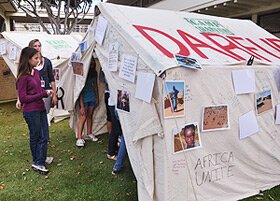This Issue
Summer 2010 - Feature
Students on Mission to Change the World
Spearheading the effort to hold Camp Darfur were, back row, substitute teacher Michael Lee, Jonah Yoshimura ’13, Reece Foy ’13, Zach Busekrus ’13; front row, Allie Kim ’13, Jordyn Yee ’13, Ashley Ellison ’13, Taryn Aranador ’13, Amy Kimura ‘13, Erin NaPier ’13, Lauren Uhr ’13, Jennifer Totoki ’13, Keely Choy ’13, Gabriel Stauring, Katie Jay Scott, and teacher Kimi Yasunaga-Frith ’92.
“What do you mean by, ‘Buy in?’” Yasunaga-Frith asks.
“They said they want to help! They want to do something,” he responds.
Five refugee tents were set up in the courtyard of ‘Iolani School. Each tent represented a period of genocide that has occurred in the world: Armenia in 1915, the Holocaust in 1938, Cambodia in 1975, Rwanda in 1994 and Darfur in the present.
Busekrus is passionate about spreading awareness of the ongoing genocide in Darfur so that the suffering ends and so that peace will come to those who must endure war and the constant threat of death. He along with his classmates produced an award winning video (http://bit.ly/a3DxNC) contrasting life in Darfur against life in the U.S. that was entered in the Olelo Youth Xchange Video Competition in March.
Each tent included educational materials and photographs to spread awareness of the horror of genocide.
Camp Darfur, an interactive educational exhibit, is somewhat like a traveling refugee camp that raises awareness and examines Sudan’s Darfur region and its humanitarian crisis – genocide – by placing it in historical context.
“We are so fortunate here, yet others around the world are suffering. We just want to do something to help,” says Busekrus.
Katie Jay Scott of Stop Genocide Now spoke to students about the situation in Darfur.
Ashley Ellison ’13 holds up a drawing done by a child in Dafur of soldiers, guns and bloodshed.
“The contrast is real and sad,” Ellison notes.
Students are learning that while ending genocide seems like an enormous challenge, it all begins by helping individuals. The names and photographs of children in Darfur were put on badges. ‘Iolani students wore the badges to symbolize their support and desire to help those suffering.
Badges with photographs and names of children living in Darfur were worn by students.

Inside each tent, were news stories, maps, and other educational presentations.
“I am amazed by how our students are so passionate about this cause,” says Yasunaga-Frith. “They all want to help. They all care. And they all know that somehow they can make a difference.”
For more information, check www.stopgenocidenow.org/campdarfur.


